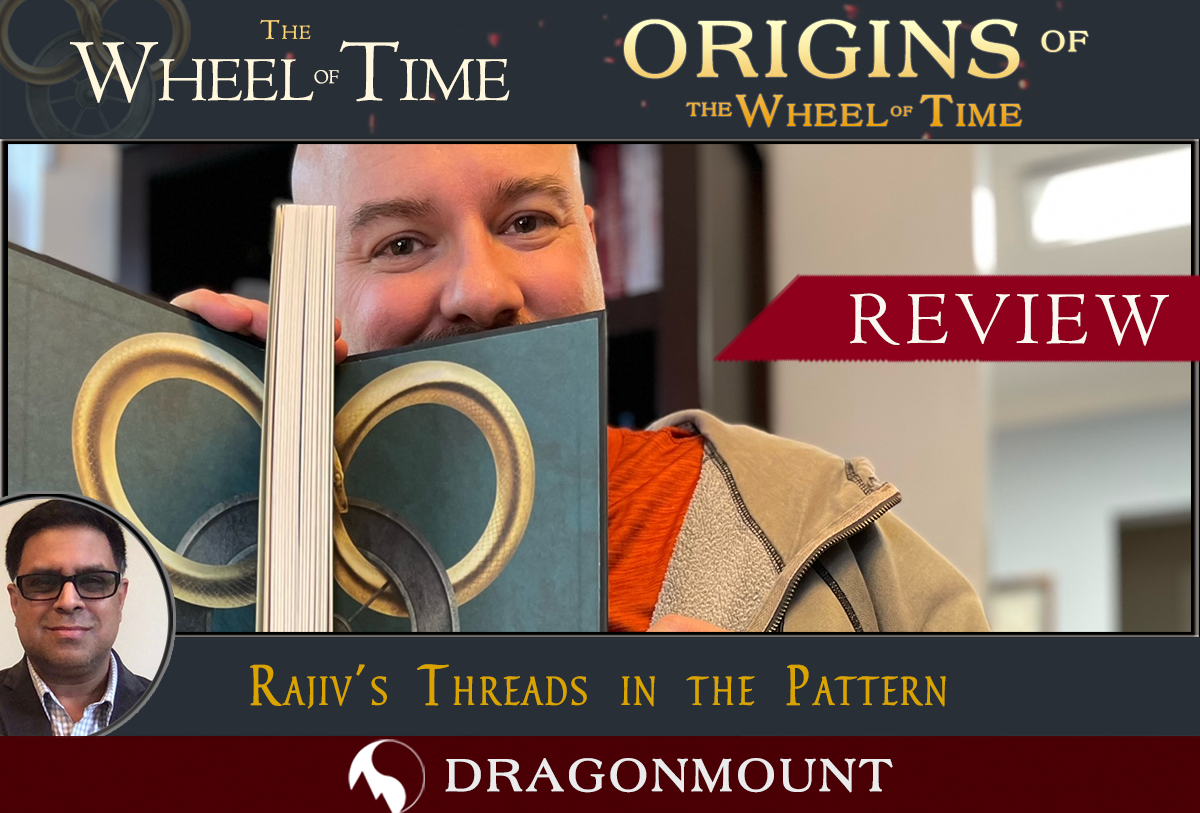
Rajiv Moté is Dragonmount’s book blogger with a lens on the craft of fiction writing. When he’s not directing software engineers, he writes fiction of his own, which can be found catalogued at his website.
Around the time The Shadow Rising was published, a friend turned me on to Robert Jordan’s The Wheel of Time by raving about the Easter eggs. It was epic fantasy like The Lord of the Rings, he said, but throughout, there were veiled references to mythology, legends, and history from all around the world. This was during a time when the internet was still text terminals and UNIX command lines, and he wanted his friends to read along and help catch all the references. Soon enough, I was on dial-up Compuserve and Usenet with all the other amateur scholars, not only trying to decode the real-world tales in Jordan’s Pattern, but trying to predict the shapes the Pattern would take with the next book. And the next.
Now, The Wheel of Time is complete, an accessible internet has crowd-sourced an enormous volume of amateur scholarship, and professional scholar Michael Livingston has written an official version of our Easter egg hunt in Origins of the Wheel of Time. For the nerdiest segment of fandom (myself included), it’s a delight. Livingston parses out the multitude of references with evidence from Robert Jordan’s own notes and known influences. But even for fans and admirers of Jordan’s world building craft, Livingston sheds light on the themes and writing process that garnered so much love and acclaim. He also shows why the Easter egg hunt is central to understanding what Jordan was trying to achieve, and perhaps even why Rand could light his pipe in the end.
Origins contains a concise biography of Robert Jordan, a contextualization with J.R.R. Tolkien’s methods behind The Lord of the Rings, and a look at Jordan’s practices as a writer. It concludes with a large section, similar to the glossaries at the end of The Wheel’s books, that go through names and terms from the story. Here, Livingston provides insights into what those names reference, and even reveals some lingering mysteries. Origins is probably not for the casual reader. But if you’ve ever engaged with The Wheel of Time on a deeper level, hunted for literary Easter eggs, studied how writers build an imaginary world, or pondered how epic fantasy--like the Wheel--spins a myriad variations on eternal themes, Origins may spark beautiful revelations. It’s also an illustration of how meeting your heroes can be a wonderful thing.
Mortality and Change
Through Jordan’s own writings and stories from “Team Jordan,” Livingston reveals a Robert Jordan who was vigorously physical, endlessly curious, and a lover of stories real and imagined. He was also a man profoundly affected by his military service in the Vietnam War, a subsequent accident in civilian life that didn’t kill him only by luck, and finally a disease that ultimately ended his life. Awareness of mortality weighed on Jordan’s entire adult life. As he wrote:
Quote
“Perhaps maturity is the knowledge that everything is going to change, that neither you nor anything you see is going to go on forever.”
-- “The Wheelwright: The Life of Robert Jordan,” Origins of the Wheel of Time
And more succinctly, “Life changes. Deal.”
Though Jordan was inspired by J.R.R. Tolkien’s The Lord of the Rings, his attitude was far less nostalgic. The inevitability of global change was a theme in his first fantasy novel, Warrior of the Altaii, and ran strong in The Wheel of Time, where the world fundamentally changed in the process of being saved. Returning from home, you have changed, and so has the place you left. You can’t go home again. And maybe that’s for the best.
As a veteran and a scholar of military history, Robert Jordan based many of his fictional battles on historical ones. In the glossary-style final section, Michael Livingston also gives references to the military references Jordan uses to inform the tactics and movements he describes so well.
Books, Lists, and Ramblings
As an amateur fiction writer myself, I was especially interested in Robert Jordan’s writing process. Through Jordan’s notes and interviews, Michael Livingston gives us a look at the writing process that created The Wheel of Time. Jordan was a voracious reader, and Livingston makes several references to Jordan’s collection of more than a thousand books. Jordan was inspired to write by an irony that many writers will recognize: he wanted more from what he read.
Quote
“I remember picking up a book by an author I knew I liked, reading a few paragraphs and tossing it across the room and saying, ‘Oh God, I could do better than that,’ Then I thought, ‘All right son, it’s time to put up or shut up.’”
-- “The Wheelwright: The Life of Robert Jordan,” Origins of the Wheel of Time
This is a sentiment echoed by the great Alan Moore, who actively encourages aspiring writers to consume the dreck along with the greats.
Quote
“As a prospective writer, I would urge you to not only read good books; read terrible books as well. Because they can be more inspiring than the good books.”
-- Alan Moore on Storytelling, BBC Maestro
Robert Jordan set out to build his world by compiling lists from what he read and elsewhere. Of character and place names, certainly, but also “of vegetation, of jobs, of songs, of idioms and sayings.” He would annotate these lists with the aspects of their meaning that captured him, and connect them--physically, with lines--to combine them into new ideas or acknowledge possible connections. A list of names became a cast of characters with interesting attributes, and the interactions in various combinations suggested plots. And once he had an idea for a character or scene, he would just start writing, interrogating the ideas on paper as he went.
Quote
“[Jordan] never wrote from a strict outline. Instead, he wrote through a state of constant dialogue with his developing story. In this process his preferred mode of creativity was brainstorming in what he called ‘ramblings’: opening a fresh document, he would begin writing what he then knew about a character, sequence, or scene. Along the way, he would ask questions of himself, even raise objections against himself, all within a written stream of consciousness.”
-- “The Wheel Turns: Jordan at Work,” Origins of the Wheel of Time
As an occasional fiction writer, I recognize this sort of brainstorming as a wonderfully creative, generative technique, where a strict plan-then-execute approach usually fails to produce results as deep and rich.
But it is his starting point, the lists of proper nouns culled from stories and the world around him, that reveals that Jordan was stitching together ideas from disparate sources into something ambitiously coherent. He was weaving a sort of conspiracy theory, implying that all the stories we know are rooted in this story, the one Robert Jordan was telling, with echoes that go backward and forward in cyclic time.
Syncretism, the Grand Conspiracy Theory
While I’d gleefully engaged in the great Easter egg hunt for veiled allusions to other stories across many fan properties, I only found a name for the practice in the last few years, reading Umberto Eco’s Foucault’s Pendulum: syncretism.
Quote
"But in its loftiest sense syncretism is the acknowledgement that a single Tradition runs through and nurtures all religion, all learning, all philosophy."
-- Foucault’s Pendulum, Umberto Eco
Both Tolkien and Jordan were syncretics in the same way as the three conspiracy theorists in Foucault’s Pendulum: they connected real details to imagine a common source underlying them. Tolkien explored this through linguistic vectors. Jordan’s vectors were stories. “The Wheel of Time turns, and Ages come and pass, leaving memories that become legend. Legend fades to myth, and even myth is long forgotten when the Age that gave it birth comes again.” All the stories were true, and shall be again.
Michael Livingston names three primary influences on Robert Jordan: J.R.R. Tolkien’s The Lord of the Rings; Thomas Malory’s Le Morte D’Arthur, his canon for the legends of King Arthur; and Robert Graves’ The White Goddess: A Historical Grammar of Poetic Myth. This last book, recommended to him by his wife and editor Harriet, was itself syncretic, claiming that the legends and myths we know were patriarchal stories pasted over the real stories of a primordial matriarchy that featured a tripartite goddess: the Maiden, Mother, and Crone. This goddess could be glimpsed in the background of every story that tried to draw focus to a newer, male god or hero. But the palimpsest was never fully cleared. Hints of the real story still showed through. Jordan not only culled many names for his lists from The White Goddess, he was inspired by the premise that there was a single myth that underpinned all others.
Quote
“Whereas Tolkien built from the nitty-gritty of words and languages both real and invented, Jordan built from the larger scope of our cultural inheritance. Where Tolkien is said to have aimed to create a ‘mythology for England,’ Jordan aimed for something even more daring and profound: a ‘mythology for humanity.’”
-- “The Axle and the Wheel: Tolkien and Jordan,” Origins of the Wheel of Time
Fan excitement in hunting for Easter eggs is the tracing of a diaspora of tales, of recognizing the secret origin of something familiar. Of course, Michael Livingston warns us not to take it too far. Jordan allowed himself to be inspired by these tales, but did not feel himself bound to them. Sometimes similarity is coincidence. Or as the narrator of Foucault’s Pendulum puts it (echoing my thoughts when I try to speculate on the Marvel Cinematic Universe):
Quote
“I was clinging stubbornly to an elegant but false hypothesis.”
-- Foucault’s Pendulum, Umberto Eco
Mysteries Revealed
While Origins of the Wheel of Time is a book that mainly tackles issues that inform Robert Jordan’s story rather than the issues in the story, Michael Livingston gives us a few interesting revelations from the notes.
If you speculate about the Prime Video adaptation of The Wheel of Time, this detail may interest you when you consider how showrunner Rafe Judson reimagined the Eye of the World.
Quote
“Samma N’Sei. Jordan originally imagined that there was not just one Eye of the World, but seven. Each of these would be associated with a seal of the Bore, and the Dark One had tasked a group of red-veiled former Aiel to destroy them. His concept of having multiple “eyes” was abandoned, but the idea of these secret Aiel was not.”
-- “The Real World in the Wheel of Time,” Origins of the Wheel of Time
We know of the Ring of Tamyrlin from the prologue of The Eye of the World, but that artifact, and the term “Tamyrlin” remained things we could only speculate about. Jordan’s notes reveal that it was not only a sign of office, but Tamyrlin was a person.
Quote
“The Aes Sedai first came into being under the direction of Tamyrlin, the first person to learn how to channel the One Power. As they organized themselves, their leader took Tamyrlin’s name as a title.”
-- “The Real World in the Wheel of Time,” Origins of the Wheel of Time
One of the big mysteries is the character Nakomi. Most of us who’ve speculated on her hit close to the truth, but Brandon Sanderson provides some interesting details about her background. I think there’s an opportunity for Rafe Judkins to weave her into the Prime Video adaptation as a recurring cameo.
Quote
“I decided that this woman was the Creator’s version of Shaidar Haran, something Jordan had explained a little in the notes. A vessel, kind of an avatar, but not quite. Shaidar Haran for the Dark One, Nakomi for the Creator. But again, not actually the Creator. … As many have guessed, her birth is Jenn Aiel. Yes, they’re still around. A few of them. And providing the vessel who was the counterpart to Shaidar Haran was part of their purpose, lore, and identity. Nakomi (which is her birth name among them) is the latest in this line.”
-- “The Real World in the Wheel of Time,” Origins of the Wheel of Time
Finally, there is the mystery of Rand’s pipe.
Quote
“One of the questions that Maria never got to ask Jordan--the next one on her list on that Friday before he passed--was about the final moment in the series: ‘How did Rand light his pipe?’”
-- “The Wheelwright: The Life of Robert Jordan,” Origins of the Wheel of Time
The notes contain no answers, and Brandon Sanderson cites this as one of the things he will never reveal. Perhaps it’s for the best. Some things ought to remain in the realm of mystery.
For my part, I think the answer reaches back to Hindu mythology, one of the mythologies Jordan incorporates into his syncretism. Consider this, from Livingston’s entry for the Amayar.
Quote
“Hindu belief suggests that this world is not as it appears to be, that what we see is Maya (often translated to mean “illusion”). In The Wheel of Time, the Amayar similarly believe that the world in which they live is “Illusion.” When Rand destroyed the Choedan Kal on their island of Tremalking, the Amayar understood this as an indication that the “end of the Illusion” had come and so committed mass suicide.”
-- “The Real World in the Wheel of Time,” Origins of the Wheel of Time
“Maya” is the divine illusion that is the world we perceive. It veils the ultimate truth of what is, and enlightenment is the process of piercing that veil. In Hinduism, we are not separate from the divine, but continuous with it. It is Maya that prevents us from realizing this.
In Jordan’s epic, the Amayar people awaited the end of illusions, just as the Aiel expected to “wake from the dream.” When Rand fought the Dark One, he stopped weaving the One Power and True Power, and started weaving the threads of the Pattern itself, his visions of reality competing with the Dark One’s. He and the Dark One vied to remake the universe. When Rand returned, perhaps it wasn’t that he could no longer touch saidin, but he now saw through its illusion. For all that everyone reminded Rand that he wasn’t the Creator, in the end, he re-wove the universe, human free will intact, and excluded the Dark One outside the Pattern. As it was once, at the moment of Creation, so it was again. Rand, who was once a character in the story, transcended to become the Creator, the storyteller. This is the ultimate enlightenment in a world created from a gleeman’s patchwork cloak of stories: awareness of being in a story. In his new body, Rand’s first desire is to follow his curiosity and see the rest of the world. Unshackled from being ta’veren, he can enjoy the free will he won for the rest of the world. The creation, the story, had a life of its own, and the free will of its characters must be respected. But much like Nakomi, Rand could give the story a nudge. He is now the author of his own story.
Quote
“He regarded his pipe, riding up a little incline to the side of Thakan’dar, now covered in plants. No way to light the tabac. He inspected it for a moment in the darkness, then thought of the pipe being lit. And it was.”
-- “Epilogue: To See the Answer,” A Memory of Light
It fits, doesn’t it?
- WheelofJuke, Blackbyrd, Vambram and 1 other
-
 4
4
-Dragonmount-Banner-Ads-1200x280.gif.ed90097d91aa5c65a5c17fab3b59c6f2.gif)
-Dragonmount-Banner-Ads-728x90.gif.a2f99d762ad611c51fbffc8b25a4efb4.gif)
-Dragonmount-Banner-Ads-320x100.gif.a233f9b759ce2a0c82ee7b9e890e85dd.gif)









.jpg.b7a8ed0c6c6b6db6eaa89411a06d40a5.jpg)
.gif.42a259ec4461f639cc9bc78adbc6ff0e.gif)
Recommended Comments
Join the conversation
You can post now and register later. If you have an account, sign in now to post with your account.
Note: Your post will require moderator approval before it will be visible.